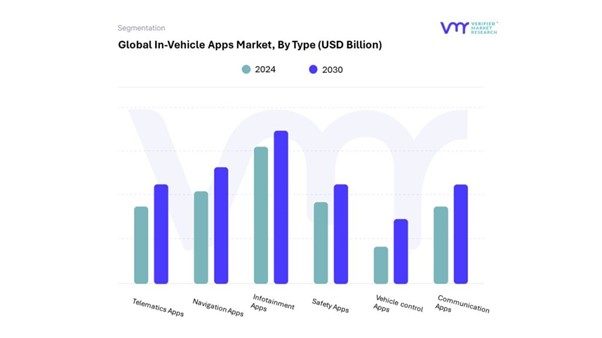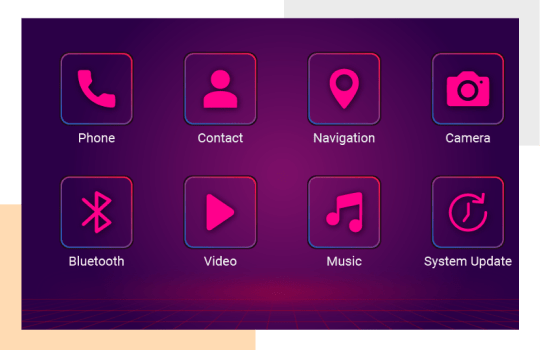In the world of connected cars, the journey is just as important as the destination.
Today, an average car buyer seeks enhanced in-vehicle experiences. They are willing to spend more to own a vehicle with connected technologies, comfort, and convenience features. Hence, car manufacturers have the important task of providing buyers exactly what they want – and are constantly redefining the boundaries of innovation to accomplish this.
So, it’s not uncommon to see modern vehicle interiors enhanced with –
- AI-powered passenger and driver monitoring apps
- Multiple dashboard displays merged into a single, sleek digital cockpit interface
- Curved, shaped and adjustable in-vehicle HMIs with 3D graphics
- Intuitive infotainment systems with advanced apps
Let’s focus on the last point above.
The role that in-vehicle infotainment apps play in transforming the experience of vehicle occupants should not be overlooked. In this article, we explore how far these apps have evolved and how they are catalysing exceptional user experiences.
What are Infotainment Apps?
Infotainment apps are the main channels through which the driver and passengers receive a range of unique services so that they stay informed and entertained during a journey.
After Google introduced Android Auto, users are able to access some of the apps residing on their phones via the in-vehicle infotainment systems. For this, the user would initiate Android Auto app on their smartphone and connect the phone (using Bluetooth or a USB cable) to the vehicle’s infotainment system. Once the pairing is successful, the apps available on the user’s phone can be accessed directly from the infotainment screen.
The infotainment systems in some newer models of cars are powered by Android Automotive – a dedicated operating system that Google introduced specifically for automotive applications. In such vehicles, an extensive assortment of infotainment apps resides on the IVI system itself.
Top car manufacturers who develop their own car operating systems are releasing custom-designed, advanced infotainment apps to their customers to ensure brand loyalty. For instance, Hyundai Motor Company and Kia Corporation have recently partnered with Samsung Electronics to implement seamless connectivity between mobility and residential spaces.
This solution enables owners of Hyundai and Kia cars to remotely control their home digital appliances through their vehicle infotainment systems. Likewise, they will be able to control various systems in their vehicles remotely from their home TVs or smartphone apps.
Automotive Mobile App Categories and Benefits
The common factor between all infotainment apps is that each one of them eases the journey of the user and elevates the travel experience to a whole new level. Let’s analyse the top 5 categories of infotainment apps:
- Navigation Apps – One of the most popular categories of infotainment apps is navigation or GPS apps. In the market, we see a wide range of these apps, as they can help drivers in traversing unfamiliar terrains to reach their desired location. Such apps also provide valuable real-time insights on traffic conditions and roadblocks, while also suggesting alternate routes to reduce the time spent commuting. These apps monitor the position of the vehicle and track it using GPS data. Maps are also integrated with these apps to guide the user.
- Music Streaming Apps – There are multiple music streaming apps being used by vehicle owners around the world. It is possible to listen to your favourite song online, without having to download it. The user can also put together their favourite music in playlists which can be accessed based on their moods.
- Parking Assistance Apps – Various innovative companies in the US and Europe have come up with the idea of developing vehicle parking assistance apps. When you are facing difficulty in finding a suitable parking spot for your vehicle in shopping centers, malls, theme parks, or any such crowded places, these apps can prove to be handy. Parking management apps make use of data retrieved from cameras, GPS, and real-time location to suggest the nearest parking slot available for the user.
- Bus or Train Ticket Booking Apps – In the mobility apps space, bus or train ticket booking apps are gaining popularity. Such apps give the user access to an online ticketing platform from where they can easily book tickets, without having to wait in queues at the counters.
- Car Service and Maintenance Apps – Vehicle owners need not worry about car maintenance schedules, as they will be reminded of a pending car service at the right time by these apps. Some of these apps also enable you to book an appointment with the car service company and they can pick up the vehicle from your residence.
What Are the Most Popular Infotainment Apps?
The most downloaded Android Auto apps in 2024 are as follows:
- YouTube for playing videos
- CARFAX for car care
- Drivvo for car management
- Waze for navigation and live traffic
- Spotify for music playback
- GasBuddy for gas prices
- Google Maps for navigation and maps
- Audible for audio entertainment
- Pocket Casts for playing podcasts
The best CarPlay apps for iPhones in 2024 are mentioned below:
- Amazon Music for music playback
- Tom Tom Go for navigation and maps
- Pandora for audio entertainment
- TuneIn Radio for radio content
- WhatsApp for messaging and communication
- NPR One for updated news on the go
- PlugShare for finding charging station locations
- Spot Hero for locating and booking parking spots
Automotive OEMs and Their Proprietary Infotainment Apps
Apart from the apps listed above, some leading car manufacturers provide customized apps to vehicle owners to enhance convenience and establish brand loyalty.
For example, Skoda offers a bouquet of in-car infotainment apps for their customers. Here are a few of them:
- Pay to Fuel – This application enables users to effortlessly make payments for fuel at petrol stations.
- Pay to Park – This infotainment app allows users to search, select and make payment for parking spaces directly from the car.
- Traffication – This app provides the driver information about the route and also notifies them of incorrect paths or directions.
- Service Scheduling – This infotainment app allows the driver to schedule servicing for the vehicle with a Skoda service partner.
- Digital Manual – This app is a digital version of the car’s manual. Vehicle owners have all the information about their car at their fingertips, even while they are commuting.
Similarly, sellers of vehicle parts have dedicated apps that enable customers to place orders and check inventories from the comfort of their homes.
Guidelines to Follow While Developing Infotainment Apps
Developing apps for infotainment systems entails much more work than simply coding for the specific OS. Mobile app developers who are proficient in developing applications for smartphones may not have the expertise to create these automotive apps. Since vehicle operating systems are not clones of mobile versions of Android OS or iOS, there are multiple unique factors to be considered when developing automotive mobile apps.
For instance, infotainment apps should operate in specific environments and on specialized automotive hardware. The design of the user interface should be such that driver distractions are minimal.
iOS and Android have released some guidelines (mostly related to safety and distractions) for developers building automotive apps:
- The UI should be minimalistic with easy-to-navigate options so that driver distraction is minimized.
- The amount of information displayed on the screen at a time should be limited.
- The visual elements should have good clarity when viewed from infotainment screens in different lighting conditions.
- The complexity and length of tasks should be short. This is based on the mandate that each off-road look at the gadget should not require more than 2 seconds of the driver’s time.
- Since the usage of the gadget is limited to a single hand, the app should be designed to
accommodate that. - The number of manual inputs needed to achieve an outcome should be limited.
Overall, the essence of these guidelines is that the information displayed by the app should complement the driving experience – rather than creating an additional layer of cognitive load on the driver.
Steering wheel buttons and voice assistants are great for assisting drivers in using their infotainment apps. However, there should be a fine balance between the excessive use of both. Too many interactions with the steering wheel buttons or infotainment screen can be distracting, while voice assist can be taxing for the driver.
In-Vehicle Apps Market Forecast
Automotive apps are essential for ensuring uninterrupted connectivity between a vehicle and the surrounding devices – such as mobile phones and wearable tech. A recent report from Verified Market Research shows that the global in-vehicle apps market size is expected to grow at a healthy CAGR of 8.59% between 2024 and 2030.

These apps promise vehicle occupants unbeatable driving experiences through the wide range of entertainment and information options that they provide. However, their benefits can be derived completely only if there is a dependable infrastructure established for communication.
Technological advancements such as 5G connectivity, extended reality (AR, VR, etc.), predictive maintenance, and remote vehicle management offer endless opportunities in this context.
Infotainment apps witnessed an exciting growth trajectory over the past few years. If you would like to stay updated on more such connected vehicle technology trends, subscribe to our blog.



